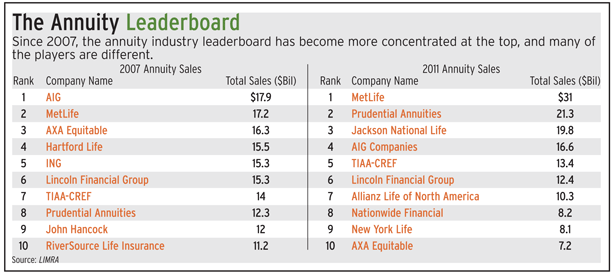Back before the Great Recession kicked off in 2008, Mark Cortazzo, senior partner with Parsippany, N.J.-based Macro Consulting Group, was pouring income-seeking clients into variable annuities, allocating 75 percent or more of such clients' portfolios to them. After all, the deals were pretty rich. In those days, he could get a 6 percent guarantee on assets invested.
“In '06 and '07, the insurance companies were giving away the farm,” he says.
Today, Cortazzo has cut his VA allocation by more than half, to around 30 percent for new income-seeking accounts. The products simply are not as beautiful as they once were. The guarantees are thinner and many of them are heavily invested in fixed income, which puts a squeeze on returns if equity markets turn north, he says. In 2007, an investor could get annuities that were heavily invested in the equity market with strong guarantees.
“I was somebody who was the biggest advocate in the world, and now I'm somebody who's saying, ‘Be cautious,’ because the products aren't as consumer-friendly as they were.”
Since the beginning of 2011, three insurance carriers — Sun Life Financial, Genworth Financial and, most recently, The Hartford — have exited the annuity business altogether. In 2010, ING abandoned its annuity business. John Hancock, owned by Canadian-based Manulife Financial, significantly scaled back its annuity business last year, and even MetLife says it expects to sell 35 percent fewer variable annuities in 2012 versus the prior year as it shifts its marketing focus elsewhere. The annuities business is now concentrated in fewer hands, and the leaderboard looks dramatically different than it did in 2007. (See chart, p. 48.) As those that are left struggle to adjust to the low interest rate environment and market volatility and make good on the robust guarantees of their past, they're dramatically shrinking guarantees on new products and making other changes to minimize their own cost and risk. For advisors and their clients, that means getting less and, in some cases, paying more for it.
“With some of the carriers getting out and some of the carriers that are staying in having less competition, that risk-reward metric is not as attractive as it was in '07, and we're looking at other ways to transfer risk,” Cortazzo says.
But many say annuities are still the only game in town for guaranteed income, and demand for those guarantees has never been higher. At the same time, insurers are going to continue to struggle to turn a profit while paying out the rich benefits on existing policies that they promised years ago. That means guarantees on future annuity products may be further cut back. If your clients need income, and annuities seem like the right choice, you might want to get in now before the guarantees lose what luster they have left.
“Now's the time to sell it because you'll look like a hero in five years, I think,” says Jeremy Alexander, president and CEO of Beacon Research, which tracks fixed, indexed and variable annuity sales, rates and features, and provides web-based systems for distributors and insurance companies.
“The bottom line is that 10 years ago people were selling what we now know as very inexpensive benefits; I think that five years from now these will look inexpensive as well.”
A Changing Leaderboard
With so many firms getting out of annuities or scaling back, the business is now concentrated in fewer hands at the top. For example, in 2007, 45 percent of the variable annuity market share was held by the top five companies; today, the top five hold 61 percent, and most of the players are different, according to LIMRA data. As of the end of 2011, MetLife, Prudential, and Jackson National Life held the top three spots in terms of sales. In 2007, AIG, MetLife and AXA Equitable were at the top of the leaderboard, followed closely by Hartford.
“I don't think it's any coincidence that some of the larger companies that we've seen bow out of the industry in the last couple of years were the market leaders in the early 2000s, so they have huge legacy blocks,” says Donnie Ethier, senior analyst at Cerulli Associates. “Hartford was a major, major player in the early to mid-2000s.”
Some of the firms that exited, including Manulife and Sun Life, were Canadian companies, and thus were subject to higher reserve requirements than U.S. firms. This was likely a big factor in their decision to exit, say analysts and b/d executives.
In the U.S., firms have faced a prolonged low interest-rate environment and stock market volatility, both of which make hedging old business more difficult. At the end of the day, carriers are guaranteeing that an annuity will accumulate at a certain rate, and with the volatility, the price of that guarantee goes up because the risk is higher, says David Rogers, practice leader for PwC's Actuarial and Insurance Management Solutions group. In addition, because these guarantees promise a fixed sum at a specific date in the future, the value of future payment is higher when rates are lower, Rogers adds.
Hedge fund manager John Paulson, Hartford's largest shareholder, had been pressuring the insurance company to separate its life insurance business from its property and casualty unit, and that's most likely the reason they ducked out of the annuity business, says Sam Friedman, insurance leader for Deloitte Research.
But Mathew Greenwald, president and CEO of research firm Mathew Greenwald & Associates, sees other reasons. Perhaps Hartford couldn't handle the increasing costs of hedging the annuities with guaranteed living benefits, he says.


As the top five continue to grab market share, many carriers are taking a step back and attempting to de-risk their annuity businesses. According to Cerulli's Ethier, that “de-risking” process has taken the form of reduced step-ups, roll-ups, and annuitization rates.
A step-up benefit is meant to protect purchase payments and earnings by locking in performance gains each year on the contract anniversary. The roll-up rate is the guaranteed percentage that the benefit base increases each year, while the annuitization rate is the amount a client would get once he or she annuitizes the contract.
In some cases, the carriers are also cutting back on the guarantees offered. At the end of last year, MetLife lowered the roll-up on its guaranteed minimum income benefit to 5 percent from 5.5 percent, according to Beacon Research. In January, SunAmerica lowered the benefit payment rate on its Polaris variable annuities from 5.5 percent to 4 percent for singles up to age 64 and from 5.5 percent to 5 percent for over age 65.
Product changes are taking other forms as well. Robert Kerzner, president and CEO of LIMRA, says some providers are launching dynamic asset allocation or target volatility funds. These funds allow carriers to offer living benefits while reducing their exposure to volatility risk by rebalancing fund allocations based on market fluctuations and risk tolerance.
Deloitte's Friedman says carriers continue to develop annuities with hybrid features, such as a long-term care policy built into an annuity or variable features built into an indexed annuity. Lincoln National, for example, rolled out its first fixed annuity long-term care policy in June.
Other new products are allocated to some alternative investments in an effort to provide higher yields. Insurers hope these products will help them meet obligations and increase profitability, Friedman says. For example, in March, Jackson National launched its Elite Access annuity, which can include a mix of alternative investment options, traditional investments, risk management strategies and tactical asset allocation strategies.
Fees and Commissions
Though the insurance carriers are trying to maximize profit and reduce risk, they are, for the most part, leaving commissions on the products alone. High commissions have historically been advisors' main gripe with annuities. Cerulli's Ethier says commissions have stabilized and are averaging 3.5 to 4 percent, and he doesn't see them coming down.
But the costs of benefit riders are rising in some cases. Ethan Young, manager of annuity research at Commonwealth Financial Network, says he has seen the costs of benefits go up across the industry. For example, in February, RiverSource raised the fee on its guaranteed minimum withdrawal benefit from 1.1 percent to 1.5 percent, according to Beacon Research.
“You could get a living benefit rider two years ago, more aggressive than the ones that are out there today, for as little as 70 basis points,” Young says.
That said, Kevin Loffredi, vice president of insurance solutions at Morningstar, says it would be far more expensive for advisors to try to replicate the same types of guarantees on their own. Beacon's Alexander says he wouldn't be surprised to see fees on riders go higher.
Confusion
For advisors, the changes in the annuity industry are going to make their jobs harder, PwC's Rogers says. Not only are the guarantees less rich, but the kinds of investment available are more varied and the rate at which contracts change is so frequent that it has become much more difficult to evaluate where the best value is for clients.
According to Morningstar, there were 381 changes to VA products in 2011, including new contracts, new benefits, fee changes, and product revisions. That's up from 342 changes to VAs in 2010. Cortezzo's firm, for example, spends at least 1,500 hours a year researching annuity products, with one full-time staffer dedicated to the space.
Michael Fein, managing partner with CIC Wealth Management Group in Owings Mills, Md., is certified in annuities, and he's amazed at how frequently the carriers adjust the features they are offering. At the end of last year, he was looking for a 10-year deferred product, and pulled up four different products to compare. Just recently, he used the same criteria to conduct the search, and three of the four players were different.
The Dilemma
Despite the changes, clients are demanding a source of guaranteed income for life, especially as baby boomers reach retirement and begin to draw down assets. According to a Curian Capital survey of more than 1,000 independent advisors, 72 percent of advisors said the market volatility has increased clients' demand for guaranteed income features.
Deloitte's Friedman sees the changes in the industry as a positive. While firms are struggling to adapt, those that survive are stronger, more focused institutions. He considers the changes in players and products sound risk management.
“If certain firms are getting out of [the industry], maybe that's a good idea for them to get out of it,” Friedman says. “You don't want a lot hangers-on that are not delivering value for their shareholders.”






